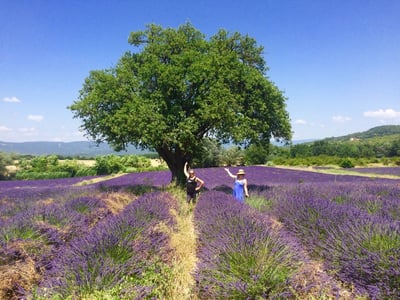Provençal Lavender
/ in Provence Vacation, Tours to Provence, Provence Travel, Tour of Provence / by smadar PalaceAhhhh Lavender! That beautiful purple-blue flowering herb that’s as versatile as it is lovely. The mere mention of the word has the nose twitching at the thought of breathing in the calming scent at once so familiar and so completely, totally French, or Provençal to be precise.
Provence, that delightful region in the South of France, is known for many things; outstanding wine, warm and welcoming people, cheeses to die for and of course, lavender.
Images of windswept and stunning lavender fields abound in any representation of Provence. But, how did that iconic and delicate flower become so entwined as to be synonymous with the region? And what are some of the ways the French use this fragrant herb in everyday life?
How Lavender Became a Symbol of Provence
Travel through the southeastern part of France in June and July and you’ll see purple-blue fields blanketing nearly the entire region. The scent of lavender is so intense during harvest that even the roses are said to smell like lavender! Can you imagine?
Lavender came to France some 2000 years ago, brought by Roman soldiers who used lavender to dress war wounds. Romans perfumed themselves lavishly in lavender oil using it in their hair, on their bodies, as a balm, in their homes, their clothes, their baths and just about anywhere they could find to impart the scent of this lovely flower. Lavender was also somewhat of a talisman to the Roman soldiers who scented their flag as they commenced into battle to ensure victory.
The Romans may have introduced lavender to the region of Provence but once there it took hold in French soil and found a home. The favorably warm climate proved ideal for propagation of this delicate blossoming herb.
During the Middle Ages lavender was used in the Mediterranean region in all manner of ways. By the 19th century Provençal locals found cultivation of lavender was quite profitable and an industry was born. Today you’ll find lavender oil, perfume, soaps, sachets and various other renderings of the alluring herb in just about every shop, every market stall and every home throughout Provence and beyond.
The Many Uses for Lavender (It’s More Than Perfume)
Lavender has many uses, as was recognized by the early Greeks and Romans who considered it a “holy herb” for its versatility. The scent is so heady and lovely it must be divine, right? Of course perfumes, room sprays, soaps and sachets are a few of the popular uses for lavender.
But lavender is much more than a fragrant plant. As an essential oil lavender placed in a diffuser or even just a few drops on your pillow at night may work to calm you and aid in combating insomnia. (Check with your physician)
A lavender sachet keeps away pests of all sorts. Deter moths from your closet by hanging a lavender sachet. Prevent pantry pests, including mice, the same way. Lavender oil is said to deter mosquitoes and other outdoor pests. No home in Provence is without lavender sachets scattered throughout.
Some people find lavender eases their stress and anxiety. Place a drop of lavender oil on your wrist before heading into that big interview. The fragrance may ease some of those jitters and you’ll smell lovely! Put some food grade lavender flowers in your tea to add a delightful flavor. It goes so nicely with Earl Grey.
And speaking of foods, food grade lavender flowers infused in butter or mixed into sugar adds a new level of delicate flavor to your baking. Make a blend of lavender flowers, mint, thyme and rosemary as a rub for pork or mix with butter and place in the cavity before you roast your next chicken. Use lavender in a marinade with some orange juice and soy sauce before grilling a batch of wings. Lavender imparts a unique and pleasant flavor so play with it in the kitchen.
What is Lavandin?
When you’re discussing lavender with those “in the know” the name “Lavandin” will inevitably come up. Lavandin is a member of the lavender family, a naturally occurring hybrid of the lavandula angustifolia (considered ‘true’ lavender) and lavandula latifolia ( a more pungent mediterranean lavender). This hybrid produces roughly ten times the amount of essential oils as true lavender.
Today most of what you will see in horticulture is this more prolific Lavandin. The scent of Lavandin is nearly identical to that of true lavender, with slightly more herbal, earthy undertones.
Are you a lover of lavender? How do you use this versatile herb?
Share this article
-
Share on Facebook
Share on Facebook
-
Share on Twitter
Share on Twitter
-
Share on WhatsApp
Share on WhatsApp
-
Share on Pinterest
Share on Pinterest
-
Share on LinkedIn
Share on LinkedIn
-
Share on Tumblr
Share on Tumblr
-
Share on Vk
Share on Vk
-
Share on Reddit
Share on Reddit
-
Share by Mail
Share by Mail



